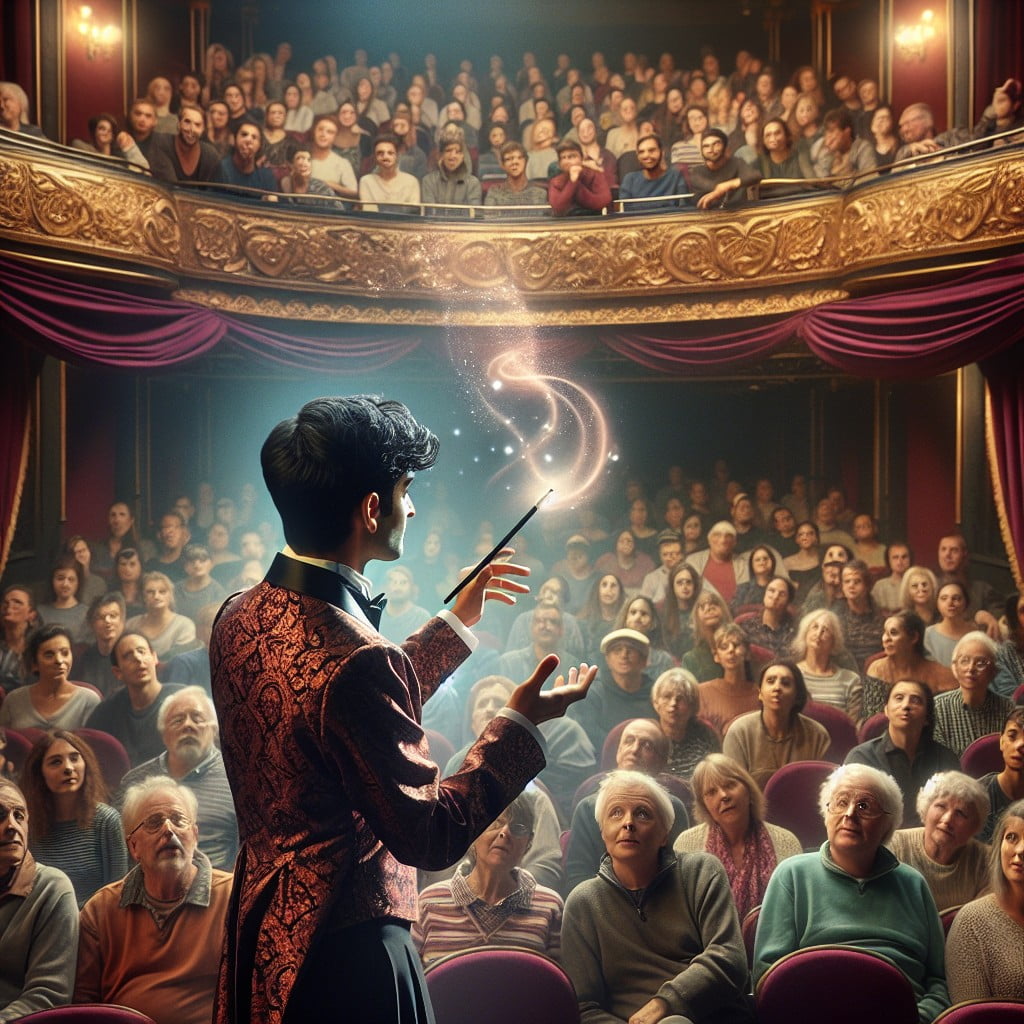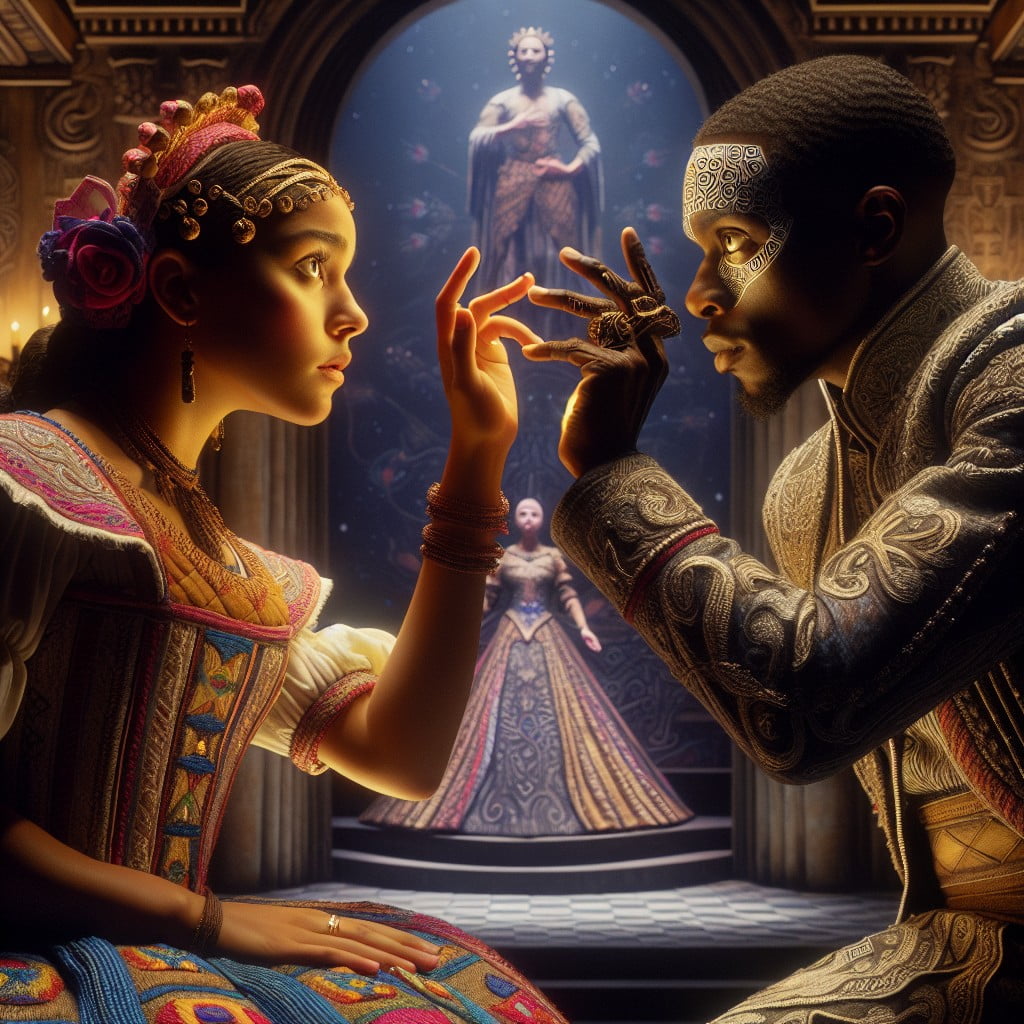Explore the transformative power of the mind control theatre because it provides a unique and engaging way to harness your mind’s potential, bringing peace, focus, and enhanced mental clarity.
Harnessing the power and scope of your mind’s theatre is akin to stepping into an expansive yet tranquil realm of untapped potential. The term ‘mind control theatre’ intriguingly aligns with guided visualization, mindfulness, and meditation — personal mind exercises designed to exercise ownership and command over the yet-to-be-explored contours of your thoughts and imagination.
This exploration aims to amplify your focus, heighten your mindfulness, and provide an overall sense of peace while navigating through life’s intricate mazes.
As you delve deeper into this article, you’ll uncover the intricate threads of mind control theatre techniques, from beginner to expert levels, and their transformative potential – an enlightening journey to achieving enhanced cerebral prowess.
Key takeaways:
- Mind control theatre encompasses various techniques and genres.
- Hypnotic stage performance showcases the power of suggestion.
- Illusionists use psychological principles to create the illusion of control.
- Theatre explores themes of control through puppeteers and telepathic dramas.
- Science fiction and dystopian plays delve into brainwave manipulation and mind control regimes.
Hypnotic Stage Performance

Hypnotic stage performance captures audiences with its blend of suggestion, psychology, and showmanship. Key to understanding this art form is recognizing its reliance on audience participation, as performers commonly invite volunteers to be hypnotized, illustrating the power of suggestion.
Skilled hypnotists utilize voice modulation, paced breathing, and storytelling to induce a trance-like state, allowing volunteers to access subconscious parts of their minds. This phenomenon showcases the concept of focused attention, where external stimuli are minimized, and responsiveness to suggestion is heightened.
Contrary to common misconception, participants maintain their free will; they are neither asleep nor under the hypnotist’s control. Instead, they experience an altered state of consciousness, often resulting in temporary changes in perception and behavior.
Ethical performers always ensure participants’ safety and dignity, embedding disclaimers about the entertainment value and refraining from genuine therapeutic practice unless professionally licensed.
Illusionist’s Mental Domination

In a captivating display, illusionists employ psychological principles to create the impression of influencing or controlling thoughts. They cleverly utilize:
- Attention redirection, guiding viewers away from the mechanics of the trick.
- Pattern recognition manipulation, baffling the mind by disrupting expected sequences.
- Social compliance, exploiting the audience’s natural tendency to follow perceived authority.
- Suggestion, planting subtle cues to influence participants’ responses.
Such techniques, although not genuine mind control, produce astonishing feats that suggest mastery over the human psyche, leaving audiences in awe of the illusionist’s apparent powers. These performances often utilize the art of misdirection, coupled with a deep understanding of human behavior, to achieve what can only be described as theatrical mind control.
Puppeteer’s Mind Manipulation Play

In the realm of theater, the portrayal of a puppeteer’s influence extends beyond strings and marionettes, delving into the psychological interplay between the controller and the controlled. This dramatic construct explores the nuanced dance of autonomy versus influence, as characters are meticulously steered through the narrative by an omnipresent force, often represented by a singular, omniscient character.
Audiences witness:
- The symbolic representation of control through physical puppetry, which mirrors the psychological manipulation occurring within the play’s narrative.
- The use of dialogue and character development to illustrate the subtleties of influencing another’s decisions, behaviors, and ultimately, their fate.
- The interplay between light and shadow on stage to visually encapsulate the dynamic of awareness versus ignorance in the context of control.
- Conflict and resolution structured around the characters’ realization and confrontation of the manipulation they have been subjected to.
- Ethical quandaries posed to the audience, provoking introspection about personal autonomy and vulnerability to external influences.
This artistic exploration encourages a deeper consideration of the forces that shape human behavior and the concept of agency within the broader tapestry of life.
Telepathic Dramas

Telepathic dramas leverage the fascination with non-verbal communication between characters. The concept is rooted in the hypothetical ability to transmit thoughts directly from one mind to another without the use of the traditional senses. This artistic device allows for a deep exploration of character relationships and inner dialogues. It offers a unique perspective on empathy, connectivity, and the boundaries of the human mind.
- Characters often share secrets and intentions without a word, adding layers of complexity to the plot.
- The technique creates a sense of intimacy and immediacy, as the audience gains direct access to the character’s innermost thoughts.
- This form of drama often delves into the ethics of mind reading, posing questions about privacy and consent.
- Storylines might also explore the potential for misunderstanding and miscommunication, even in a seemingly transparent form of interaction.
- It serves as a metaphor for deep understanding and the unspoken bonds between individuals.
Science Fiction: Brainwave Manipulation
In the realm of science fiction, the manipulation of brainwaves forms a compelling foundation for storytelling. This concept involves altering or controlling a character’s thoughts, emotions, and actions through technological means. Enhanced EEG devices and neural interface technology serve as typical plot devices to explore ethical quandaries and the potential of the human mind.
- Technologically-induced telepathy allows characters to communicate non-verbally or control others from a distance.
- Brain implants can be used to augment reality, implant memories, or alter personalities, questioning the essence of identity.
- Emotion control technologies can create Utopian or Dystopian societies by suppressing negative feelings or enforcing compliance.
- Ethical implications arise around consent, freedom of thought, and the nature of individuality in the face of such invasive technology.
Science fiction serves as a mirror, reflecting current concerns about emerging neuroscience and the future of cognitive liberty.
Espionage: Subliminal Messages Spectacle
In exploring the world of theatrical espionage, subliminal messages hold center stage. These messages are cleverly woven into a performance, operating below the level of conscious perception to influence the audience without their explicit awareness. Key components include:
- Visual Cues: Images flashed briefly or embedded within the set design can influence thoughts and emotions subtly.
- Auditory Suggestions: Sounds or words layered beneath music or dialogue can alter perceptions and decision-making.
- Narrative Techniques: Storylines that present particular ideologies or biases can shape beliefs and attitudes over time.
- Symbolic Props: Objects with cultural or emotional significance can transmit messages indirectly.
Theatrical performances seeking to incorporate espionage elements use these methods as a means of conveying a deeper message or critique, often reflecting on societal issues, political climates, or human psychology. The effectiveness lies in the meticulous crafting of cues that bypass critical thinking, leaving a lasting impression.
Surrealism: Dream Control Theatre
Surrealism in the theatrical realm transcends ordinary reality, ferrying audiences into the depths of the subconscious. The dramatization of dreams allows viewers to explore ethereal narratives that defy logical constraints. This form of theatre draws on the following:
- Visual metaphor and symbolism: Set designs, costumes, and props often embody abstract concepts and emotional states, providing a visual lexicon for interpreting the narrative.
- Nonlinear storytelling: Plots may progress in loops, jumps, and seemingly disordered sequences, reflecting the unpredictable nature of dreams.
- Displacement and surprise: Characters and situations may transform unexpectedly, mirroring the fluidity of dream logic.
- Audience Interpretation: Spectators are invited to derive personal meanings from the ambiguous and multilayered dream sequences.
- Emotional resonance: Beyond intellectual understanding, the aim is to engage viewers on an emotional and visceral level, often eliciting profound reactions through bizarre and intense dream depictions.
In essence, this theatre sub-genre challenges perceptions, opens the door to introspection, and taps into the collective unconscious, inviting an exploration of the human psyche’s most enigmatic corners.
Paranormal Influence in Drama
When examining the intersection of paranormal phenomena and theatrical performances, several core concepts emerge. Plays and productions often draw upon the intrigue of the unknown, weaving narratives that challenge the viewer’s perception of reality.
- Spectators may encounter storylines featuring psychics or clairvoyants, whose abilities drive the plot and offer insight into the unseen world.
- The incorporation of ghosts, spirits, or otherworldly entities adds a layer of supernatural tension, creating a bridge between the material world and the afterlife.
- Techniques such as dim lighting, eerie sound effects, and suggestive dialogue are utilized to establish an atmosphere ripe for paranormal occurrences.
- The suspension of disbelief is critical; audiences are invited to engage with the premise that beyond the tangible lies a realm of mysterious forces.
- Through the characters’ experiences with paranormal influence, themes of fate versus agency, the power of belief, and the consequences of attempting to control the uncontrollable are commonly explored.
Psychological Thriller: Mind Games
In psychological thrillers, the manipulation of the characters’ perceptions often drives the plot. Scriptwriters craft scenarios where:
- Reality is distorted, challenging the audience to discern truth from illusion.
- Characters employ emotional leverage to influence others, weaving intricate webs of betrayal and trust.
- Mind games serve as a battleground, where psychological warfare supersedes physical confrontations.
- The unpredictability of characters’ actions keeps viewers on edge, as they try to outthink the protagonists and antagonists alike.
- Strategic use of flashbacks or non-linear storytelling disorients the viewer, mirroring the characters’ confusion.
- Moral dilemmas force characters to question their own beliefs, suggesting that control is often internal rather than external.
Each element is designed to engage the audience through suspense and the cerebral unravelling of the characters’ inner worlds.
Audience Participation: Suggestibility Tests
Inviting the audience to participate in suggestibility tests transforms spectators into an active component of the performance. These exercises typically begin with simple instructions that lead participants through a series of tasks or questions designed to demonstrate how easily the human mind can be influenced.
Common examples include:
- The Balloon and Book visualization, where audience members are asked to imagine a balloon tied to one wrist and a heavy book in the other hand, then observe how their arms respond.
- Pattern interruption, which involves breaking a routine action to highlight how the mind operates on autopilot and can be redirected.
- The Lemon Test, where imagining biting into a juicy lemon elicits salivation, illustrating the mind-body connection.
- Word association games to reveal how quickly the mind can connect and be primed with ideas and concepts.
Such activities not only entertain but also educate on the power of suggestion and the potential for control through psychological cues. They underline the subtlety with which thoughts can be steered and offer a glimpse into the principles of hypnosis and suggestibility that demand further exploration.
Futuristic: AI Mind Control
In envisioning the integration of artificial intelligence in theatrical productions, AI’s role in mind control represents a cutting-edge evolution of performance art. Here are several key concepts to consider:
- Interactivity: Through AI, audience members may influence the storyline in real-time, with their collective choices directing the plot.
- Personalization: AI could analyze real-time reactions from viewers to tailor performances, potentially modifying dialogue or actions to elicit specific emotional responses.
- Predictive Technology: Utilizing machine learning algorithms, AI may be able to predict audience reactions, thus enhancing the storytelling to maintain engagement or provoke thought.
- Biometric Feedback: Wearable technology can provide feedback to the AI system, allowing the play to shift according to the physical responses of the audience, such as heart rate or facial expressions.
Understanding these elements provides insight into how AI can revolutionize the theatrical experience, offering a glimpse into the profound potential of technology to shape narrative and control in future storytelling.
Magic Show: Hypnotism Techniques
In the realm of magic, hypnotism stands out as a compelling component, captivating audiences with the illusion of mind control. Deeply rooted in psychology, these techniques hinge on the power of suggestion and the subject’s susceptibility.
Key points that elucidate this fascinating aspect of magic include:
- Inducing Trance: Magicians often start by guiding volunteers into a relaxed, trance-like state through calibrated verbal cues and focused breathing exercises. In this state, individuals may become more open to directives.
- Authority and Trust: The effectiveness of hypnotic induction is greatly enhanced when the magician establishes themselves as a figure of authority. Trust between the hypnotist and the volunteer is also crucial, as it fosters a cooperative environment.
- Selective Suggestion: Not everyone responds to hypnotism in the same way. Magicians adept at hypnotism choose participants based on observable cues that suggest a propensity for suggestibility, such as heightened imagination or concentration.
- Rapid and Progressive Techniques: Quick induction methods might involve sudden, unexpected commands or actions, while progressive techniques build gradually, layering suggestions to deepen the trance state.
- Environmental Control: The setting plays a significant role. Soft lighting, ambient music, and the collective focus of the audience can create an atmosphere conducive to hypnotic experiences.
- Posthypnotic Actions: Often, participants are given posthypnotic suggestions that trigger specific actions or responses after they “awaken,” showcasing the lingering influence of the hypnotic session.
Understanding these points provides a glimpse into how magicians use the art of hypnotism not to dominate the mind, but to create enthralling illusions that leave audiences in awe of the seemingly limitless power of the human psyche.
Psychic Abilities in Theatre
Engaging with the ethereal, theatres often explore the mysterious realm of psychic phenomena, leaving audiences mesmerized by the concept of mind-to-mind connections. Here are a few key points that explain how psychic abilities are represented on stage:
- Clairvoyance, or “clear seeing,” is depicted through characters who foresee future events or have visions that unfold in the storyline, often portrayed with dramatic lighting and atmospheric effects.
- Telepathy is used to create a silent dialogue between characters, who might exchange information or emotions through focused attention and without the need for words, enhancing the dramatic tension.
- Mediumship provides a bridge between the living and the dead, demonstrated through seances or the channeling of spirits, typically accented by haunting audio cues or spectral visuals.
- Psychokinesis, or the ability to move objects with the mind, adds a layer of the supernatural, with objects levitating or being manipulated, sometimes requiring intricate stage props or machinery.
Through the skilled use of these elements, the theatre becomes a canvas for the mystical, inviting the audience to suspend disbelief and ponder the existence of psychic powers beyond the physical world.
Immersive: Virtual Reality Mind Control
Engaging with immersive virtual reality (VR) introduces a paradigm where the digital environment can deeply influence the mind. The sensory inputs from VR are so powerful that they can override signals from the real world, resulting in a unique form of cognitive and emotional engagement.
- Utilizes sophisticated headsets and controllers to create a compelling, interactive experience that can alter perception.
- Blurs the line between reality and simulation, influencing the brain’s response to virtual scenarios as if they were actual experiences.
- Applications range from therapeutic settings, where VR is used to retrain cognitive processes, to entertainment, where it intensifies the emotional impact of storytelling.
- Allows for the simulation of environments and situations that can evoke empathy, understanding, and a shift in perspective more effectively than traditional media.
- Raises ethical considerations about the extent to which mind control through immersive virtual environments should be used, especially concerning personal autonomy and privacy.
Understanding the power and influence of VR is critical as we navigate its integration into various aspects of life, from education to ethics, and consider its potential to shape human thought and behavior.
Mind Control in Propaganda Plays
In theater, propaganda is a powerful tool for swaying public opinion. Plays that utilize this form of mind control craft their narratives to align with specific ideologies, subtly influencing audiences through emotion and persuasion rather than direct argument.
- Storytelling techniques: Playwrights employ compelling characters and plots to evoke empathy, making the underlying message more digestible.
- Symbolism: Symbolic elements within the set, costumes, and dialogue are leveraged to reinforce the intended message without overt explanation.
- Emotional appeal: Music, lighting, and dramatic performances are orchestrated to create an emotional response that aligns with the play’s message.
- Repetition: Key phrases or slogans are often repeated throughout the play to reinforce the core message and ensure it lingers in the audience’s minds.
- Antagonist portrayal: Villains in propaganda plays typically embody opposing ideologies, serving to discredit alternative viewpoints.
- Heroic ideals: Protagonists often personify the virtues of the promoted ideology, positioning it as inherently righteous or desirable.
Timeless Conflict: Free Will Vs Control
The concept of free will versus control is a central theme that continues to captivate audiences. This eternal struggle touches upon the depth of human experience, challenging our understanding of autonomy and influence.
Dramatizations often explore how characters assert their independence against formidable forces seeking to manipulate their actions and thoughts.
Plays and performances can portray the subtle ways in which societal norms and expectations can exert a form of mind control, subtly directing choices and behaviors.
Contrasts between the illusion of choice and the reality of control can be highlighted, inviting the audience to reflect on the authenticity of their own decisions.
The tension between a character’s desire for freedom and the external pressures that constrain them can serve as a powerful narrative drive, often culminating in a critical moment of decision.
Such narratives can also delve into the psychological aspects of control, such as gaslighting or coercive persuasion, and their impact on the individual’s psyche.
By examining these themes, theatre can serve as a mirror to society, urging viewers to consider their own lives and whether they are truly the authors of their destiny.
Dystopian: Mind Control Regimes
In dystopian narratives, control over the populace is often wielded through invasive mental tactics. Central powers manipulate collective consciousness to maintain order and quash dissent.
Here are core elements:
- Technology as a Tool: Advanced technology is used to broadcast propaganda directly into citizens’ minds, reinforcing the regime’s ideology.
- Educational Indoctrination: Curricula in schools are designed to shape thought patterns, ensuring conformity from an early age.
- Language Restriction: Limiting vocabulary and altering language controls thought, as seen in Orwell’s Newspeak in ‘1984’.
- Surveillance State: Constant monitoring creates a climate of fear, influencing behavior and thoughts without direct intervention.
- Psychological Warfare: The use of fear, misinformation, and psychological tactics to break down individual resistance and enforce societal norms.
These elements together create a chilling backdrop where the autonomy of the mind is under siege, serving as cautionary tales about the power and dangers of unchecked authority over the psyche.
Romantic: Love As a Form of Mind Control
Love often captivates the heart and mind, wielding an influence that can overshadow logic and self-control. In the realm of theatre, this powerful emotion is portrayed as a form of enchantment that can steer characters’ decisions and alter their perceptions, mirroring the captivating effect of traditional mind control.
- Emotional Bonds: Strong connections between characters are depicted as having the power to manipulate actions, leading individuals to act in ways they might not otherwise choose.
- Infatuation’s Spell: Characters may be shown so smitten that they lose touch with reality, much like being under a spell, highlighting love’s ability to cloud judgment.
- Sacrifice and Persuasion: Love might drive characters to perform acts of great sacrifice or to be persuasively manipulated by others, showcasing its compelling nature.
- Chemical Reactions: The neurochemical processes triggered by love, like increased dopamine and oxytocin, mimic the physiological effects of mind-altering substances, offering a biological basis for love’s overpowering influence.
- Obsession: The fine line between love and obsession is a common theme where the obsessive nature skews the boundary between affection and control.
- The Power of Suggestion: Subtle cues or hints within romantic interactions can direct a person’s behavior, a psychological parallel to the suggestions used in hypnosis.
Addressing these points in a performance can lead to a nuanced understanding of love’s potency and its sweeping effects on the individual psyche.
Horror: Possession and Exorcism
Drawing from a rich well of fear and the unknown, horror themes in mind control theatre often play on the primal terror associated with loss of self. Through narratives of possession, audiences confront the unsettling idea of an alien consciousness taking over a person’s will.
Key aspects include:
- The portrayal of possession as an unwelcome invasion of the mind, typically by a malevolent entity, whether demonic or supernatural.
- The dramatization of exorcism rituals, highlighting a battle for the possessed individual’s liberation from the entity’s grip.
- Techniques used to create tension and fear, such as suspenseful music, disjointed movements by actors, and guttural voice transformations to lend credibility to the possession.
- Symbolic representations of inner turmoil and psychological conflict, suggesting a deeper metaphorical meaning to possession beyond the literal.
- The utilization of special effects and makeup to visually illustrate the transformative and often terrifying effects of possession on the human body.
This aspect of mind control theatre taps into the collective curiosity and fear surrounding the concept of autonomy and the unsettling thought of it being wrestled away by an external force.
Mind Control Mystery: Whodunit Edition
Delving into the fascinating realm of detective dramas with a twist, audiences find themselves questioning not just the identity of the perpetrator, but also the reliability of their own thoughts. This genre toys with the concept of manipulation, nudging one to ponder the vulnerability of the human psyche.
- Characters in such stories often encounter psychological tricks or hypnosis, making viewers doubt if actions are of their own volition or externally influenced.
- Using a thrilling mix of suspense and mystique, these narratives challenge the audience to unravel clues while contending with implanted memories or false beliefs.
- Manipulation is sometimes executed through technological means, suggesting a futuristic angle where minds are programmable.
- The plot may include a mastermind character with the ability to outwit others, adding a layer of complexity as truth and illusion become indistinguishable.
- Mysteries of this nature play with the philosophical debate of reality versus perception, effectively keeping the audience guessing until the final act.
These mind control mysteries engage the audience’s intellect and imagination, ensuring an enthralling experience that questions the essence of truth and free will.